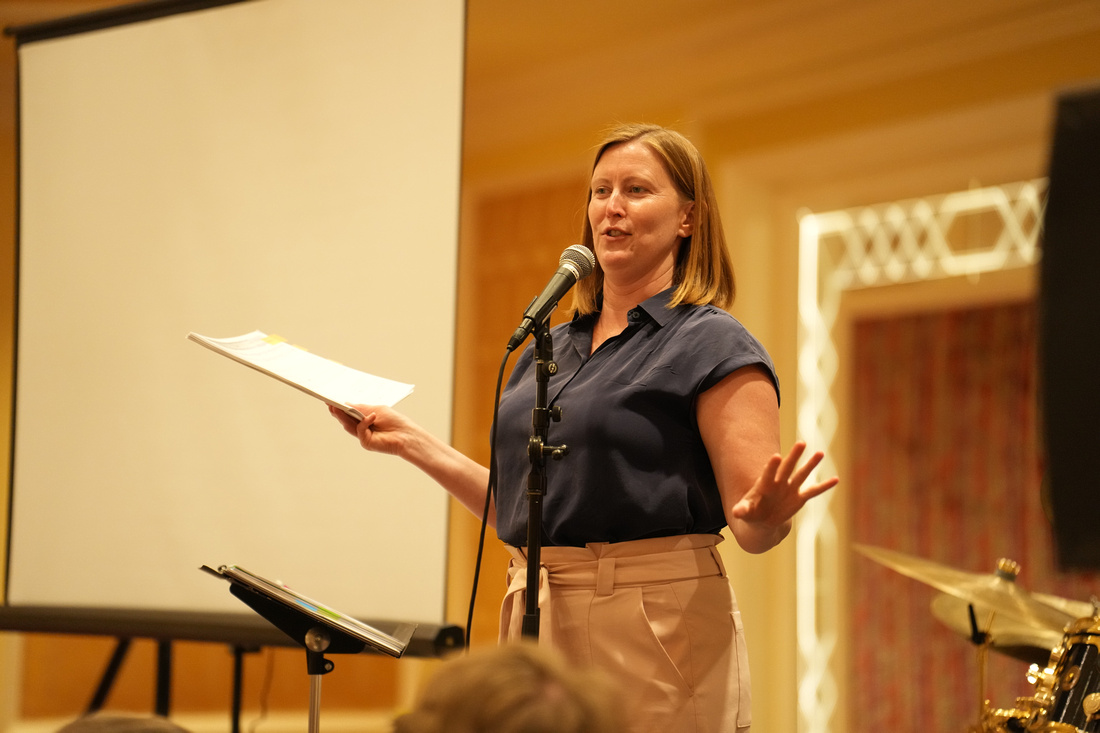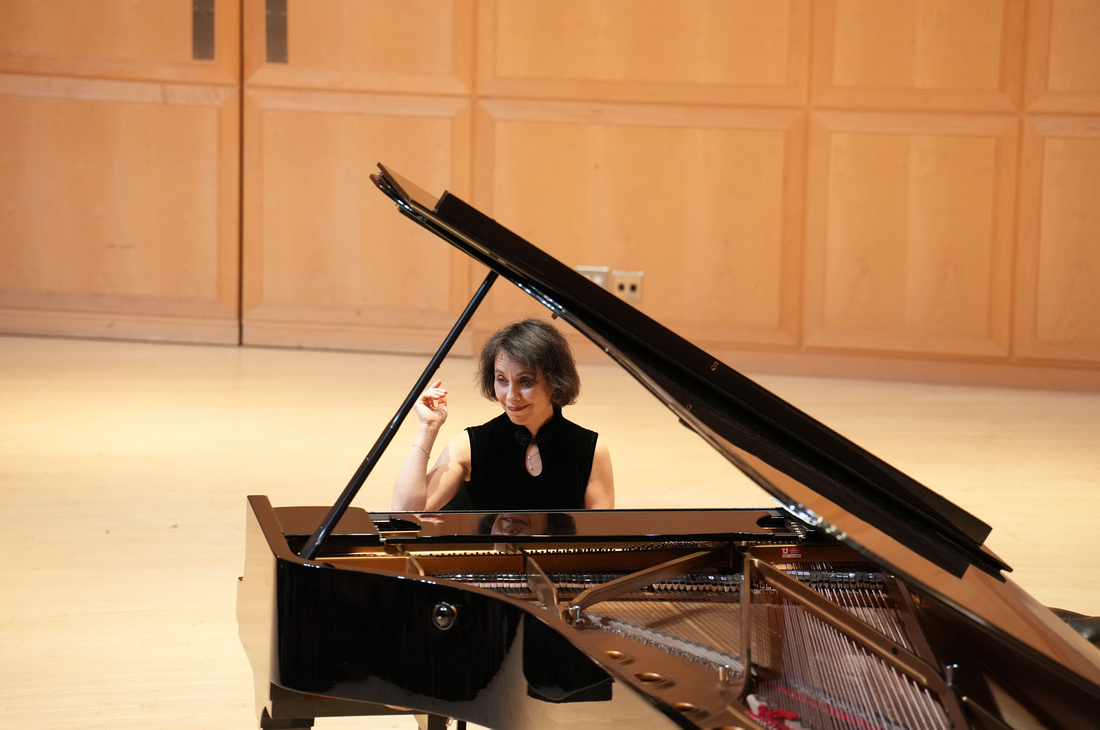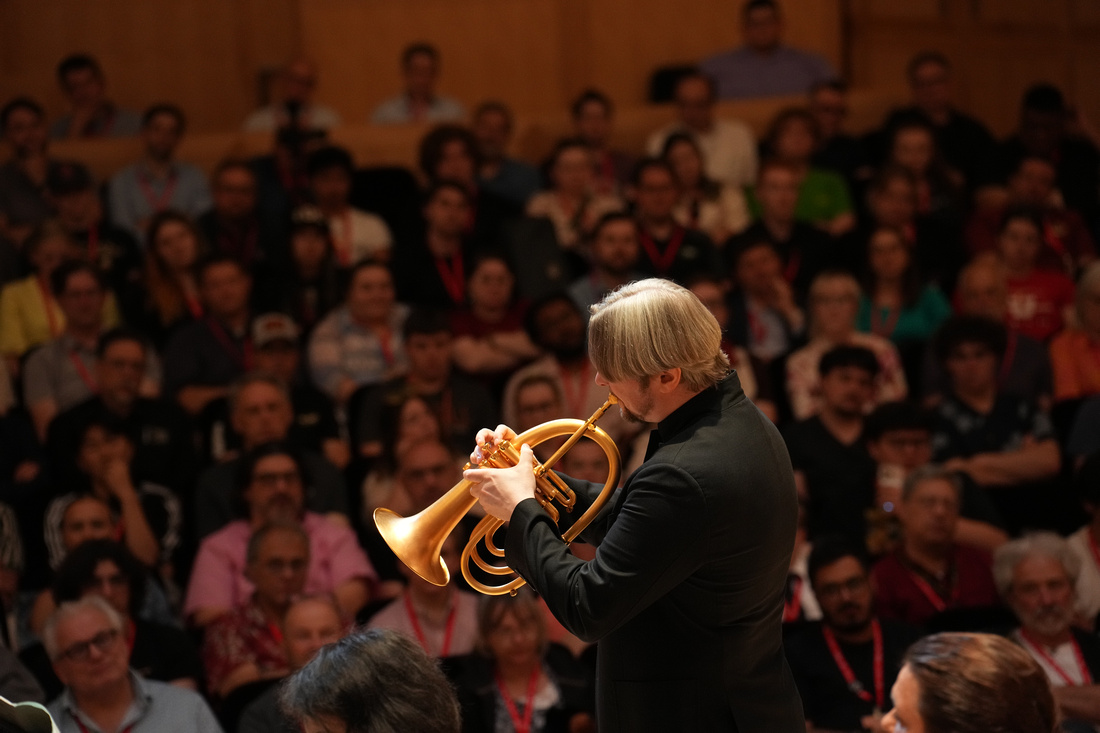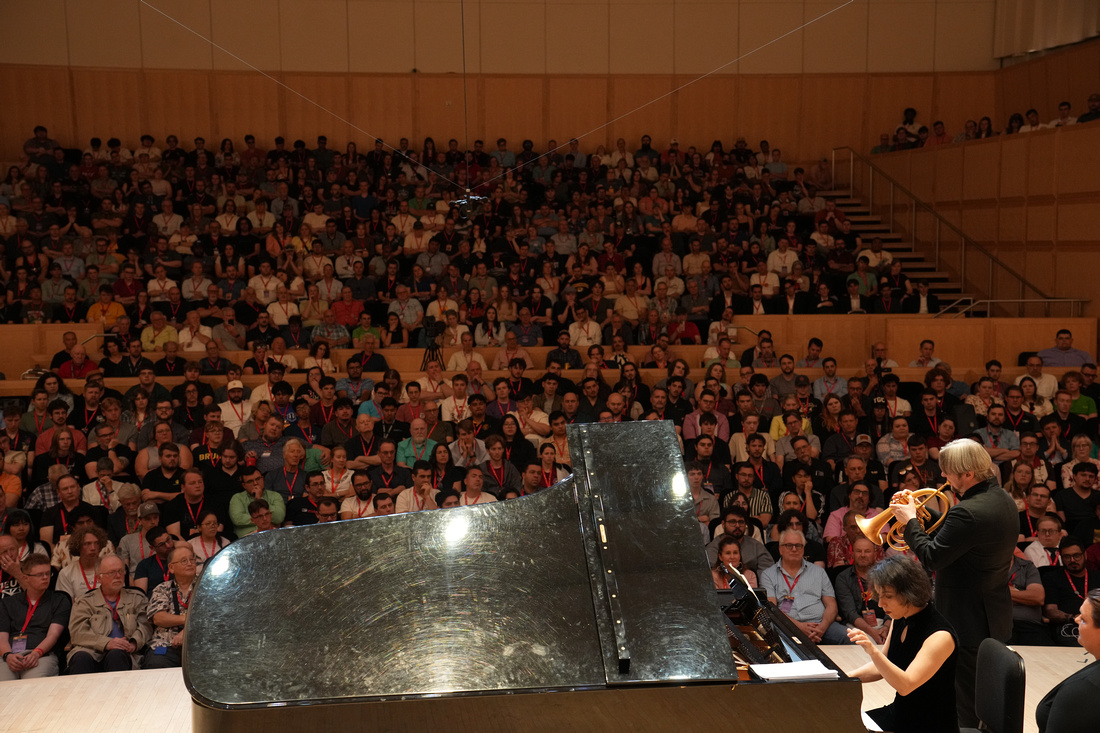2025 ITG Conference Report - Day 4 - Friday, May 30
The 49th Annual International Trumpet Guild Conference - Salt Lake City, Utah (USA)
Special Daily Report • Compiled by Peter Wood
Photos by Harmon Dobson, Anthony Salabarria, and Joe Smith
Friday, May 30, 2025
Warm-Up Session with Nairam Simoes-Samba Sunrise: A Trumpet Warm-up Journey through Brazilian Rhythms
Nairam Simoes led a large group of early-rising trumpeters in a fresh and exciting warm-up session. Simoes focused on making the warm-up process easier and more efficient. Originally from Brazil, he used many different genres of Brazilian music, such as samba, forro, and frevo, to demonstrate the importance of warming up the body and mind with rhythm and dancing. Shifting focus to the horn, Simoes stressed the importance of understanding why we play the exercises we do in our warmups. He discussed the importance of connecting mouthpiece buzzing to your ears, using leadpipe buzzing to ensure an immediate response, building momentum in the airstream, and finding balance between the tongue and air column when articulating. Simoes’s use of Brazilian music added a fresh, exciting spin on the warmup, and his focus on why we should play the exercises we do in our sessions left the class feeling determined and confident in tackling the challenges of playing the trumpet. (Braden Collison)
Derek Ganong session-Using Digital Audio Workstation Technology to Enhance Applied Teaching
Derek Ganong’s presentation explored the pedagogical impact of integrating Digital Audio Workstations (DAWs) into trumpet instruction—a practice he began during the pandemic. This technological shift has fundamentally reshaped the teacher-student dynamic, fostering greater student agency and critical listening. Rather than seeking direct feedback, students now arrive with observations about their own playing and ask informed questions. DAWs provide visual and auditory feedback through waveform analysis, enabling precise comparisons of note length, articulation, and tone production. Demonstrating with Studio One, Dr. Ganong modeled multi-track recordings of etudes and fundamental exercises to illustrate how teachers and students can collaboratively assess and refine performance. This approach promotes a more reflective, multimodal, and inclusive learning environment while deepening essential skills such as audiation. Ultimately, Ganong’s method positions DAWs as powerful tools for developing a more self-aware, musically literate student. (Kyle McLean)
Junior Youth Competition
The junior youth division of the Ryan Anthony Memorial Trumpet Competition was a heartfelt and inspiring celebration of young trumpet talent. With adjudicators Steve Felix, Bailey Paugh, and Kyra Sovronsky and emcee Erika Izaguirre, the event honored the legacy of the late Ryan Anthony by showcasing the talents of the next generation of trumpet players.
Miles Wong opened the competition with Charlier’s Etude No. 2, a bold choice that demonstrated his willingness to tackle demanding material. His performance featured moments of beautifully centered tone and sensitive dynamic nuance. Joonseo Cheung followed with Charlier 1, offering a commanding opening and well-shaped dynamic contrasts. His assured approach and tonal confidence made for a strong and engaging performance. Minseo Chung performed Charlier 12 entirely from memory. This performance stood out for its accuracy, resonant sound, and vivid character. Chung’s confidence and control elevated this technically complex etude into a compelling musical statement. Hope Webb performed Böhme’s Etude No. 9. Her warm sound and expressive vibrato created an emotional and appropriately mournful performance. Chuming Pan closed the competition with Charlier 6. His pure tone and delicate upper register made the quiet moments especially striking. Throughout the competition, the young performers demonstrated remarkable poise, technical skill, and artistic sensibility. (Matthew Vangjel)
Senior Youth Competition
The senior youth division of the Ryan Anthony Memorial Trumpet Competition always delivers an impressive group of young musicians, and this year’s edition did not disappoint. Held on Friday morning and judged by a great panel, each of the seven contestants played well and should be proud of their efforts. Though there were long wait times between the competitors, the audience enjoyed hearing the performances by these talented young trumpet players.
Daniel Lee started with a strong, bold sound, showing nice dynamic contrasts as well as good use of rubato. He showed good skill in the tricky slurred sections and finished his etude strongly.
Elias Nuspl was the second contestant and performed Charlier’s Etude No. 2 with a sweet sound and tasteful vibrato throughout.
Tyler Blood performed Charlier 11 and also demonstrated very nice contrasts in dynamics and styles, playing with a full sound in all of the louder dynamics.
Kay Carson played a captivating Charlier 2. Carson’s opening phrase was sweet and mysterious, and she performed well, showing off a rich sound in both low and high registers.
Toby Mar played Charlier 15 and had a strong opening, filling the room with a big, full sound. He impressed on the lyrical portions and didn’t struggle at all with the challenging slurs. Mar showed great musical diversity and contrasted the opposing styles well with a strong finish.
Leon Ye followed Mar and played Charlier 10, opening with a clean sound and quick finger work. Ye had a pleasant, light touch when appropriate, but didn’t hesitate to fill up the room in the louder sections.
Michelle Park concluded the competition with Charlier 28. With a truly impressive triple tongue, Park opened boldly with a remarkable sound. She also showed great contrast and fantastic control throughout this very technical etude. The event ran well, and all the contestants performed at a very high level. (Spencer Wallin)
Non-Pro Reading Session with Seretta Hart
Making a return following its successful introduction at last year’s ITG Conference, this non-pro reading session led by Seretta Hart featured over fifty trumpeters of all ages and abilities. Hart led the ensemble through John Moss’s arrangement of Three Renaissance Dances, Giovanni Paolo Cima’s Laudete Dominum, and Eric Ewazen’s Concert Fanfare. She provided additional tips on how to be successful in a large trumpet ensemble, stating that clarity of articulation and relaxation to help with sound are essential to playing successfully in an ensemble. Seretta Hart’s expertise and the camaraderie and excitement of playing in such a large group left a lasting impression on each player. (Braden Collison)


New Works Recital #2
The second New Works Recital, emceed by board member David Collins, was a dynamic and engaging showcase of contemporary compositions for trumpet. Featuring eight performances that ranged from jazz-inspired energy to lyrical introspection, the evening highlighted the instrument’s remarkable versatility and expressive potential.
The program opened with the Colorado State University Trumpet Ensemble, under the direction of Stanley Curtis, performing Chris Evan Haas’s Thermal Whiplash. The ensemble played with palpable enthusiasm, delivering crisp articulation, soaring melodic lines, and rhythmic drive. A lyrical flugelhorn solo and Harmon-muted section added contrast before a rousing finale brought the piece to an exciting close.
This was followed by Sam Young’s Flying Home, featuring Michael Gause, Robert White, Joe Cooper, George Carpten, and Chris Scanlon. With its radiant tone, excellent intonation, and joyful rhythmic momentum, the piece felt both accessible and artistically rich—an ideal concert opener or closer.


Peyden Shelton, the conference’s local host, then performed John Costa’s Front Runner (2025) with Mitchell Giambalvo on piano. Inspired by Utah’s commuter rail, the piece features musical depictions of countryside vistas and train whistles. Shelton brought command and clarity, particularly in the vibrant upper register and sharply defined rhythmic passages.


Caprice in Contrast (2024) by Michael Kahle, performed by Robert Sears and Giambalvo, followed with a thoughtful blend of lyrical lines and jazz-tinged harmonies. Sears’s nuanced phrasing and use of mute color changes made for a compelling and polished performance.
A more introspective mood arrived with the second movement of Joseph Turrin’s Sonata, performed by Aaron Hodgson. His pure, resonant tone and carefully shaped phrases captured the emotional depth of Turrin’s harmonic writing, creating a moving and memorable performance.
Garrett Klein performed Nathan Hudson’s The Hopes and Dreams of Flightless Birds (2023), a two-movement work that alternated between flugelhorn and trumpet. The lyrical first movement evoked a sense of hopeful flight, while the second shifted to a darker, more unsettled tone, using extended techniques and shifting harmonies. Klein’s expressive range and technical control were particularly notable.
In R. Christopher Teichler’s Deadline (2025), Christopher O’Hara delivered a dramatic and engaging performance. Giambalvo’s persistent piano ostinato underscored the piece’s sense of urgency while O’Hara navigated the contrasting moods of anxiety and resignation with clarity and poise.
Steffi Tetzloff performed Brandon Dicks’s WindSprints (2025) on flugelhorn, a lyrical and evocative work inspired by a leaf’s journey through the air. Tetzloff’s warm tone and expressive phrasing offered a gentle, yet technically impressive, moment in the recital.
The program concluded with Erik Morales’s Mardi Gras Trio (2020), featuring T.J. Tesh (trumpet), Alex Purdy (tuba), and Rebecca Wilt (piano). Dressed in Mardi Gras beads, the trio brought festive energy and stylistic flair. From the soulful opening to the fast-paced, bluesy finale, the performance was both virtuosic and joyful.
This well-curated recital highlighted fresh voices in trumpet repertoire and showcased the outstanding artistry of each performer. (Matthew Vangjel)
Emerging Professionals Session with William Leathers-Opera Orchestra Section Playing
William Leathers, principal trumpet of the Nashville Symphony and Santa Fe Opera, led an opera section coaching that focused on refining ensemble performance and individual technique. In Bach’s Magnificat, he emphasized following the principal trumpet, with special attention to style, balance, and tuning. His insights helped students better align their playing within the section. During Wagner’s Tannhäuser, Leathers guided players through complex passages by reinforcing the importance of timing and rhythmic subdivision. Additional works, including Bizet’s Carmen and Wagner’s Götterdämmerung, allowed students to apply these skills in various operatic contexts. At the end of the session, Leathers offered students opportunities to play solo excerpts, giving them practical experience and personalized feedback. The result was a clear improvement in both individual and group performance as students demonstrated enhanced musical awareness, precision, and confidence. Leathers’s coaching proved invaluable in bridging technical mastery with operatic artistry. (Jacinda Ripley)


Michael Hawes session-Finding a Voice: My Journey Through Severe Lip Injury and Addiction
Following a fantastic performance by the Drake University Trumpet Ensemble of Melody Dawning’s The Heavens Resplendent at Twilight and Andrew Classen’s arrangement of When a Man Loves a Woman, Michael Hawes took the audience through his very personal journey overcoming injury. During his freshman year at Northwestern, he tore his orbicularis oris and was forced to have surgery to repair it. Thus began his journey back to playing trumpet. Hawes shared the challenges, both physically and mentally, of his journey. Interspersed throughout his session, Hawes performed beautifully, showcasing his arrival back to being a trumpet performer. He also shared ways to avoid injury, such as programming intelligently, setting a person up for success, and ensuring that students are not taking on too much at a young age. He shared that he studied singing while recovering from his injury, and he performed a vocal work for the audience, demonstrating that there are more musical outlets than just the trumpet. A true, passionate musician, his story and presentation were enlightening and inspiring. (Davy DeArmond)


ITG Board of Directors General Meeting
The ITG General Meeting fosters transparency and gives members a direct voice. This year’s meeting brought exciting updates from the board. ITG Website Director Keith Sells announced a multi-year overhaul to make the ITG site more user friendly and accessible in more languages—aiming to make it the top online trumpet resource. Conference Director Rebecca Wilt shared upcoming conference plans. The 2026 conference will be held May 26–30 at the Eastman School of Music in Rochester, New York, just an eight-minute walk from hotels. In 2027, ITG heads to the University of Kentucky in Lexington, with events at the School of Music and the nearby Gatton Student Center and low-cost housing available on campus. In 2028, ITG will go international, meeting June 14–17 at the MTU Cork School of Music in Cork, Ireland. Wilt hopes to take ITG abroad every four years, and the board sees continued growth in ITG in the years to come. (Ryan Perry)
Hayato Kodama Recital
This afternoon’s recital opened with an exciting performance of Marcus Grant’s Suite for Six Trumpets by the Arkansas State Trumpet Ensemble. Following that, Hayato Kodama’s recital was an impressive demonstration of musical artistry, technical skill, and expressive depth. Opening with Arthur Honegger’s Intrada, the Japanese prodigy delivered a commanding performance marked by refined musical sensitivity and dynamic control, capturing the work’s dramatic spirit. Kodama’s rendition of Bizet’s “Flower Song” from Carmen was notable for its warm, lyrical tone and heartfelt expressiveness, beautifully conveying the romantic essence of the piece. His interpretation of Teiichi Okano’s Oboro-Zuki-Yo stood out for its delicate phrasing and evocative portrayal of the piece’s serene, moonlit atmosphere, revealing his deep understanding of the work’s poetic and emotional nuances. The recital culminated with Gershwin’s Rhapsody in Blue, on which Kodama showcased remarkable versatility and virtuosity, blending classical precision with jazzy vitality and spirited flair. Throughout the program, Kodama’s rich tone, impeccable technique, and thoughtful musical interpretation captivated the audience, making this recital a memorable and inspiring musical experience. (Maryna Pohlman)


Keith Karns session-How to Teach Jazz: Success Strategies for the Classical Trumpet Studio
The California State University, Fresno, trumpet ensemble gave an exemplary performance of Steven Franklin’s Trumpet Sextet #1 to start the session. Keith Karns performed too, displaying great ease of sound production and technical facility, which became the crux of his presentation. He posited that many undergraduate players choose to pursue only classical or jazz performance styles. Instead, players should be cultivating multiple ways to make a living and would benefit from developing a great tone, honing fundamental skills, and improving their aural skills. Karns played several audio examples of great jazz players who have full command of sound and technique, dispelling myths that these great players championed style over fundamental skill. He further advocated for a non-negotiable approach to fundamentals through practicing simple melodies in all keys, Clarke studies, jamming from memory with others daily, and deep listening. (Joseph Cooper)


Emerging Professionals Seminar with Mark Clodfelter, Part C–Take the Lead: Perform, Present, and Propel Your Career Forward
Mark Clodfelter offered valuable guidance on how to effectively present oneself across professional contexts, whether through writing, speaking, or formal auditions or interviews. He emphasized the importance of clear communication in resumes, CVs, interviews, and media interactions. When writing a CV or resume, Clodfelter advised focusing on relevance, including achievements that reflect one’s skills while omitting vague or outdated information. He highlighted the need to communicate not just qualifications, but also one’s values, goals, and potential contributions to an organization. Preparation is key, but so is authenticity. Whether in teaching, research, or service, Clodfelter encourages professionals to align their messaging with their genuine identity. By staying true to yourself while tailoring your message to your audience, you can stand out in meaningful ways. His approach fosters confidence and clarity in professional self-presentation, building a strong foundation for long-term success. (Jacinda Ripley)


Ellsworth Smith Trumpet Competition Winner Recital: Robin Paillet
The 2024 Ellsworth Smith Trumpet Solo Competition winner’s recital opened with the Southern Utah University trumpet ensemble, directed by David Torres. Their rendition of Eric Ewazen’s Concert Fanfare filled the Libby Gardner Hall with harmonically rich textures and colors. Hailing from Paris, France, Robin Paillet commenced his program with Jolivet’s Air de Bravoure. Demonstrating his musical prowess, Paillet took no delay in setting a mesmerizing and spectacular aural landscape. Following some kind words of appreciation and gratitude to the audience, Paillet brilliantly executed the popular Legende by Enescu. Many angular and flashy phrases were complemented by Paillet’s masterful tone and technique in other works by Schmitt, Desenclos, Shapero, and Gaubert. Of particular note was the exceptional synergy between Paillet and the fabulous pianist Gail Novak. Gracing the attendees ears with his exquisite and vibrant timbre, Robin Paillet delivered a fantastic recital that showed clearly why he won the Ellsworth Smith competition. (Peter Nionakis)
Affiliate Chapters in Concert
This year’s ITG Affiliate Chapters recital featured a vibrant and diverse selection of performances from university and regional trumpet guilds, showcasing a wide spectrum of styles, instrumentations, and artistic expression. The trumpet ensemble from the University of North Dakota opened the program with a bold and resonant performance of Anthony Plog’s Fanfare, followed by Eric Ewazen’s Fantasia for Seven Trumpets. The Sierra Trumpet Guild performed James Stephenson’s Fanfare for an Angel, a soaring and riveting performance that was exceptionally well received. Next, the Southern Mississippi Trumpet Guild delivered Three Preludes by George Gershwin, arranged by one of their ensemble members, Robert Smith. Their vibrant playing brought a great deal of energy and charm. ITG President Elect Sarah Stoneback conducted the Gallatin Trumpet Guild in a trio of works including Gordon Jacob’s The Canterbury Flourish, Gwyneth Walker’s When the Trumpets Sound, and Astor Piazzolla’s Libertango (arr. Chris Woods). The Utah State University Trumpet Guild performed Wasatch Front by Thomas Rohrer, a flowing and exhilarating work that pays tribute to Utah’s iconic mountain range. The Colorado State University Trumpet Guild brought light-hearted joy with The Rakes of Mallow by Percy Grainger, a whimsical and dance-like piece that highlighted the ensemble’s dynamic range and versatility. The Wyoming Trumpet Guild showcased the brilliance of the trumpet with Kent Boulton’s Milestone, featuring fast flourishes and exhilarating melodic lines. The program concluded with a memorable performance by the Utah Trumpet Guild, presenting a fifteen-part arrangement of Henry Mancini’s Moon River. This version was based on Jacob Collier’s 2019 rendition and arranged by Seretta Hart, Randy Lee, Kris Gilmore, Dan Jonas, and Braden Eddington. Conducted by Seretta Hart, the ensemble included thirty players, making it the largest of the recital and featuring the youngest trumpeters at the conference. Instrumentation included piccolo, C, and B-flat trumpets, as well as flugelhorn and baritone, delivering a lush and memorable close to the concert. (Kyle McLean)
Jason Crafton, Garret Klein, Calvin Godfrey, and Richard Masters session - Rediscovering Soviet Trumpet Repertoire
This session commenced with the Boise State University Trumpet Ensemble which provided an energetic and passionate prelude performance of Erik Morales’s Infinite Ascent. The presenters of the main event, joined by Ryan Gardner, Peyden Shelton, Sudduth Alexander, and Brian Walker, then performed a bold fanfare for seven trumpets, serving as a transition from the prelude performance to the presentation of several lesser-known pieces by Soviet composers. These composers were scattered across the vast expanse of the Soviet Union and shielded from the West by the Iron Curtain. The presenters took turns performing with beauty of tone and technical prowess. They showcased the bold sounds, sardonic wit, lush melodies, and technical challenges presented by the compositions of Schelokov, Smirnova, Korganov, Svirsky, Karim-Kodzhi, Bagdonas, Pakhmutova, Vasiliev, and Arutiunian. These works would be great additions to the established trumpet repertoire for musicians in search of beautiful and challenging music for trumpet and piano or trumpet quartet. (Joseph Cooper)


James Vaughen recital
Following a colorful and sonorous prelude performance of James Olcott’s arrangement of Here's That Rainy Day and David Roth’s Fired Up! by the North Dakota State University trumpet ensemble, James Vaughen, the new principal trumpet of the Minnesota Orchestra, presented an engaging program of newly transcribed works for trumpet and piano. Joined by his mother, pianist Ann Newton Vaughen, he opened with Massenet’s Meditation from Thaïs, showcasing his delicate and controlled piccolo trumpet technique. The remainder of the program highlighted Vaughen’s lyrical phrasing and sensitivity to the trumpet–piano duo format, featuring expressive interpretations of works by Mozart, Debussy, Price, and Brahms. A standout moment was the premiere of Adrian Wong’s cradle, a poignant piece that explores the parent-child relationship. Its gentle, rocking motion and long, flowing lines provide a beautiful vehicle for Vaughen’s artistry and tonal nuance. The entire program reflected the conference theme, “Sing, Sing, Sing,” through Vaughen’s beautiful singing lines that gracefully matched the figurations of the music. (Spencer Brand)


Sergei Nakariakov recital
The renowned trumpet virtuoso Sergei Nakariakov delivered a masterful recital that captivated the audience with its exceptional artistry and technical brilliance. The evening concert commenced with an engaging prelude performance of Jacques Castérède’s Six Pièces Brève En Duo by Baylor University’s talented trumpet ensemble, whose polished and spirited presentation set an excellent tone for the concert.
The program opened with Wolfgang Amadeus Mozart’s Violin Sonata in A, K. 305, a work originally composed for violin and piano. Nakariakov’s interpretation on the flugelhorn was both illuminating and nuanced, demonstrating his ability to translate string literature into a compelling wind performance while preserving the lyrical elegance and classical clarity that characterize Mozart’s style.


Following this, Nakariakov’s collaborative pianist, Maria Meerovitch, played Schumann’s Arabesque, Op. 18, which was marked by lyrical sensitivity and precise technique. Her nuanced phrasing and expressive touch brought out the piece’s delicate contrasts, engaging the audience with emotional depth.


Camille Saint-Saëns’s “The Swan” from The Carnival of the Animals was another highlight of the evening. Nakariakov’s performance captured the serene beauty and gentle lyricism of the piece, evoking the graceful movement of the swan with fluid phrasing and exquisite tonal control. The program continued with Schumann’s Adagio and Allegro, Op. 70, a challenging and emotionally rich composition. Nakariakov’s dynamic contrast and articulation brought out the dramatic tension inherent in the work, balancing the tender adagio with the energetic allegro passages, thereby showcasing his versatility and expressive depth.


Maria Meerovitch then performed another piano solo: Frédéric Chopin’s Two Waltzes, showcasing her technical finesse and expressive nuance, capturing the lively brilliance and lyrical elegance of the pieces with charm and grace.
Pyotr Ilyich Tchaikovsky’s works featured prominently in the recital, with performances of Lensky’s Aria (Kuda, Kuda) and None but the Lonely Heart. Nakariakov’s renditions of these Russian melodies were imbued with heartfelt emotion and poignant expressiveness. His sensitive tone and phrasing conveyed the profound melancholy and yearning that is embedded in Tchaikovsky’s music.
The recital concluded with Robert Schumann’s Fantasiestücke, Op. 73, a piece that demands both technical finesse and emotional insight. Nakariakov’s interpretation was compelling, delivering the contrasting moods with clarity and passion, thus providing a fitting and memorable conclusion to the evening’s program.


After a roaring standing ovation, Nakariakov and Meerovitch gave the audience one last little treat, a performance of Poulenc’s C’est ainsi que tu es. Overall, Sergei Nakariakov’s recital was a remarkable demonstration of trumpet artistry and interpretative skill. His ability to adapt compositions written originally for other instruments, combined with his exquisite tone and musical intelligence, offered the audience a unique and deeply moving concert experience. (Maryna Pohlman)
Competition Finals: Jazz
The final round of the jazz improvisation division of the Ryan Anthony Memorial Trumpet Competition drew a large and enthusiastic crowd. The finalists, Jean-Baptiste Rousseaux, Joey Curreri, and Zeb Jewell-Alibha, each performed their own interpretation of Dolphin Dance, the required chart for the competition, in addition to two individually selected pieces. Rousseaux, a native of France and the first to compete in this round, showed off his strong technique and unique style that serenaded the crowd. Zeb Jewell-Alibha, hailing from North Carolina, followed with a bold and exploratory set. His use of silence and sonic interjections in his improvisation created a larger idea that kept listeners on the edge of their seats. Closing the night, Joey Curreri from California brought intensity not only through his finger dexterity, but also through his big sound that captivated listeners. This event was judged by Trent Austin, Summer Camargo, and Sean Jones and was a terrific, refreshing introduction to these very fine rising musicians. (Benjamin Dubbert)





